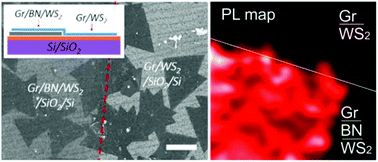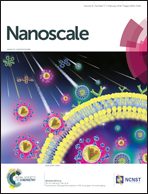Mixed multilayered vertical heterostructures utilizing strained monolayer WS2†
Abstract
Creating alternating layers of 2D materials forms vertical heterostructures with diverse electronic and opto-electronic properties. Monolayer WS2 grown by chemical vapour deposition can have inherent strain due to interactions with the substrate. The strain modifies the band structure and properties of monolayer WS2 and can be exploited in a wide range of applications. We demonstrate a non-aqueous transfer method for creating vertical stacks of mixed 2D layers containing a strained monolayer of WS2, with Boron Nitride and Graphene. The 2D materials are all grown by CVD, enabling large area vertical heterostructures to be formed. WS2 monolayers grown by CVD directly on Si substrates with SiO2 surface are easily washed off by water and this makes aqueous based transfer methods challenging for creating vertical stacks on the growth substrate. 2D hexagonal Boron Nitride films are used to provide an insulating layer that limits interactions with a top graphene layer and preserve the strong photoluminescence from the WS2. This transfer method is suitable for layer by layer control of 2D material vertical stacks and is shown to be possible for all CVD grown samples, which opens up pathways for the rapid large scale fabrication of vertical heterostructure systems with atomic thickness depth control and large area coverage.


 Please wait while we load your content...
Please wait while we load your content...